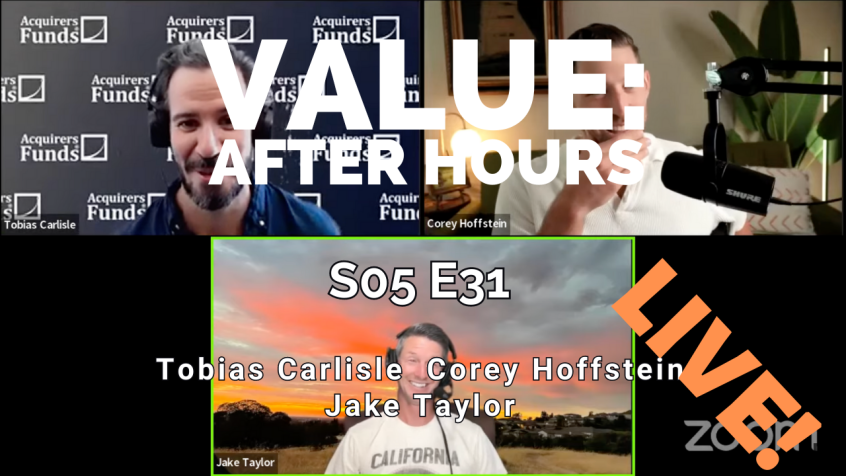During their latest episode of the VALUE: After Hours Podcast, Hoffstein, Taylor, and Carlisle discussed Value Is Not A Defensive Factor. Here’s an excerpt from the episode:
Corey: I think this is maybe one of the, I don’t want to say, fundamental problems some people fall into, but value did so well in the dot-com era that it got the reputation as being a defensive factor.
Tobias: Yeah.
Corey: I don’t think that’s inherently true.
Tobias: I agree.
Corey: I just think the dot-com era was a set up for value to be defensive because it was a valuation bubble.
Tobias: Yeah.
Corey: But not every recession has an associated valuation bubble. So, it doesn’t inherently have to be a defensive factor, and yet it might get bucketed as such simply because of our understanding of history. So, [crosstalk]
Tobias: It certainly wasn’t the last one. In the last big drawdown, it wasn’t defensive. But then I have sometimes said, the reason that it performed so well in the 2000s is because it did so badly in the late 1990s.
Corey: Right.
Tobias: Then was very, very wide. And then similar sort of thing through that like 1999, 2000, I think rhymes somewhat with 2019, 2000. It’s not a 20-year cycle. It just so happens that they fell at about that point. Even though I think value is relatively cheap relative to the expensive side, we haven’t seen like– It drew down more in the 2020 bust than most of the value ETFs drew down more than the market through that period of time. I don’t think that there’s been any sufficiently big drops since then to really test and find out. Although 2022, I would say, value tracked basically the rest of the market hasn’t stood out yet anyway.
Corey: Yeah.
Jake: I think another anomaly too with that dot-com time period was the quality of the businesses in the value bucket were really high. You had tons of cash flow at that point. ROEs of that worst decile, cheapest decile, were higher than the best or top 10 most expensive version. So, that’s a very, very rare set up where you get both really cheap and also pretty good companies in there. I don’t think we’ve really seen that since.
Corey: Yeah, my recollection you talk about– Again, this is one of those great examples of statistical time versus behavioral time, which I stole from Cliff Asness in this idea of like, I can look at a chart and be like, “Statistically, this is a small blip. It’s anomaly. Behaviorally living through that is so hard.”
Jake: Yeah.
Corey: So, to your point, Toby, which I think Coca-Cola is a great example. Coca-Cola peaked in June 1998, and then went on to have a 50% drawdown to 2003. I don’t think that was a company I’d have to go back and look at the valuations. But my recollection is like, Coca-Cola was not massively overvalued in 1998.
Jake: Ah yeah, it was.
Tobias: I think it’s pretty straight.
Jake: It was like a 60– [crosstalk]
Corey: This is why I can’t be a value guy.
Jake: [laughs] Yeah.
Tobias: is Buffett held– [crosstalk]
Corey: Was it really a 60 PE?
Jake: Oh, yeah.
Corey: Oh, wow.
Tobias: Yeah. I think through that late 1990s is often, people remember it as a dot-com bubble. It was as much a large growth bubble as it was anything else, because if you look at– I did this exercise in about 2015. I was buying a lot of leaps in 2015, because there are a lot of these really old like Walmart and Microsoft. I don’t think I looked at Coke, but there are a few of those names like that. The underlying fundamentals were great. They were still growing roughly like the way that they had been into that bust. But they’d been so expensive that it took them 10 years or 15 years to work off the overvaluation. So, the stock prices were all flat for these giant companies. And so, there was no vol in the leaps either. So, the leaps were cheap and the companies were cheap.
I remember, distinctly remember, buying them in 2015 thinking, “I’ve only got two years for these leaps to run. I hope that’s enough time for these things to come back to life, because they haven’t done anything for 15 years.” They did come back to life then. I wish I’d bought more, but those things happen.
Jake: That was pretty smart.
Tobias: I think– [crosstalk]
Corey: How come you didn’t tell me?
Jake: [laughs] Yeah.
Corey: Where’s the call, man?
Jake: We were definitely friends back then. [laughs]
Corey: I guess we weren’t, Jake.
Tobias: One of the things– [crosstalk]
Corey: Not that close.
Jake: Yeah.
You can find out more about the VALUE: After Hours Podcast here – VALUE: After Hours Podcast. You can also listen to the podcast on your favorite podcast platforms here:
For all the latest news and podcasts, join our free newsletter here.
Don’t forget to check out our FREE Large Cap 1000 – Stock Screener, here at The Acquirer’s Multiple:



